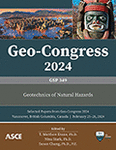Development of Synthetic Ground-Motion Records through Generative Adversarial Neural Operators
Publication: Geo-Congress 2024
ABSTRACT
Realistic strong-motion accelerograms of earthquakes are required for various earthquake engineering tasks, including modeling structural and site response to large and near-source events. In this work, we introduce a data-driven framework for three-component ground motion synthesis intended for engineering applications. Leveraging the increase of ground-motion data from seismic networks and recent advancements in machine learning, we train a generative adversarial neural operator (GANO) to produce realistic three-component acceleration time histories conditioned on moment magnitude (M), rupture distance (Rrup), time-average shear-wave velocity at the top 30 m (Vs30) based on a California dataset compiled from PEER NGA-West2 database, and a public DesignSafe California database. The results show that the framework can efficiently recover the magnitude, distance, and Vs30 scaling of Fourier amplitude and pseudo-spectral accelerations. Through a comprehensive residual analysis using empirical data, we have verified that our model accurately captures both the mean values and aleatory variability of the evaluated ground-motion parameters.
Get full access to this article
View all available purchase options and get full access to this chapter.
REFERENCES
Abrahamson, N. A., W. J. Silva, and R. Kamai. 2014. “Summary of the ASK14 Ground Motion Relation for Active Crustal Regions.” Earthquake Spectra, 30 (3): 1025–1055. SAGE Publications Ltd STM. https://doi.org/10.1193/070913EQS198M.
Afshari, K., and J. P. Stewart. 2016. “Validation of Duration Parameters from SCEC Broadband Platform Simulated Ground Motions.” Seismological Research Letters, 87 (6): 1355–1362. https://doi.org/10.1785/0220160086.
Bayless, J., and N. A. Abrahamson. 2019. “An Empirical Model for the Interfrequency Correlation of Epsilon for Fourier Amplitude Spectra.” Bulletin of the Seismological Society of America, 109 (3): 1058–1070. https://doi.org/10.1785/0120180238.
Bhosale, A., R. Davis, and P. Sarkar. 2017. “Vertical Irregularity of Buildings: Regularity Index versus Seismic Risk.” ASCE-ASME Journal of Risk and Uncertainty in Engineering Systems, Part A: Civil Engineering, 3. https://doi.org/10.1061/AJRUA6.0000900.
Boore, D. M. 1983. “Stochastic simulation of high-frequency ground motions based on seismological models of the radiated spectra.” Bulletin of the Seismological Society of America, 73 (6A): 1865–1894. https://doi.org/10.1785/BSSA07306A1865.
Boore, D. M. 2003. “Simulation of Ground Motion Using the Stochastic Method.” Pure appl. geophys., 160 (3): 635–676. https://doi.org/10.1007/PL00012553.
Campbell, K. W., and Y. Bozorgnia. 2014. “NGA-West2 Ground Motion Model for the Average Horizontal Components of PGA, PGV, and 5% Damped Linear Acceleration Response Spectra.” Earthquake Spectra, 30 (3): 1087–1115. SAGE Publications Ltd STM. https://doi.org/10.1193/062913EQS175M.
Chiou, B. S.-J., and R. R. Youngs. 2014. “Update of the Chiou and Youngs NGA Model for the Average Horizontal Component of Peak Ground Motion and Response Spectra.” Earthquake Spectra, 30 (3): 1117–1153. https://doi.org/10.1193/072813EQS219M.
Douglas, J., and H. Aochi. 2008. “A Survey of Techniques for Predicting Earthquake Ground Motions for Engineering Purposes.” Surv Geophys, 29 (3): 187. https://doi.org/10.1007/s10712-008-9046-y.
Frankel, A. 2009. “A Constant Stress-Drop Model for Producing Broadband Synthetic Seismograms: Comparison with the Next Generation Attenuation Relations.” Bulletin of the Seismological Society of America, 99 (2A): 664–680. https://doi.org/10.1785/0120080079.
Goodfellow, I., Y. Bengio, and A. Courville. 2016. Deep Learning. MIT Press.
Goulet, C. A., J. Watson-Lamprey, J. Baker, C. Haselton, and N. Luco. 2008. “Assessment of Ground Motion Selection and Modification (GMSM) Methods for Non-Linear Dynamic Analyses of Structures.” Geotechnical Earthquake Engineering and Soil Dynamics IV, 1–10. Sacramento, California, United States: American Society of Civil Engineers.
Graves, R. W., and A. Pitarka. 2010. “Broadband Ground-Motion Simulation Using a Hybrid Approach.” Bulletin of the Seismological Society of America, 100 (5A): 2095–2123. https://doi.org/10.1785/0120100057.
Hanks, T. C., and R. K. McGuire. 1981. “The character of high-frequency strong ground motion.” Bulletin of the Seismological Society of America, 71 (6): 2071–2095. https://doi.org/10.1785/BSSA0710062071.
Katsanos, E. I., A. G. Sextos, and G. D. Manolis. 2010. “Selection of earthquake ground motion records: A state-of-the-art review from a structural engineering perspective.” Soil Dynamics and Earthquake Engineering, 30 (4): 157–169. https://doi.org/10.1016/j.soildyn.2009.10.005.
Kempton, J. J., and J. P. Stewart. 2006. “Prediction Equations for Significant Duration of Earthquake Ground Motions considering Site and Near-Source Effects.” Earthquake Spectra, 22 (4): 985–1013. SAGE Publications Ltd STM. https://doi.org/10.1193/1.2358175.
Luco, N., and P. Bazzurro. 2007. “Does amplitude scaling of ground motion records result in biased nonlinear structural drift responses?” Earthquake Engineering & Structural Dynamics, 36 (13): 1813–1835. https://doi.org/10.1002/eqe.695.
Naeim, F., and M. Lew. 1995. “On the Use of Design Spectrum Compatible Time Histories.” Earthquake Spectra, 11 (1): 111–127. SAGE Publications Ltd STM. https://doi.org/10.1193/1.1585805.
Rahman, M. A., M. A. Florez, A. Anandkumar, Z. E. Ross, and K. Azizzadenesheli. 2022. “Generative Adversarial Neural Operators.” arXiv:2205.03017 [cs, math].
Rezaeian, S., and A. Der Kiureghian. 2012. “Simulation of orthogonal horizontal ground motion components for specified earthquake and site characteristics.” Earthquake Engineering & Structural Dynamics, 41 (2): 335–353. https://doi.org/10.1002/eqe.1132.
Shi, Y., G. Lavrentiadis, D. Asimaki, Z. E. Ross, and K. Azizzadenesheli. 2023. “Broadband Ground Motion Synthesis via Generative Adversarial Neural Operators: Development and Validation.” arXiv.
Silva, W. 1996. Description and validation of the stochastic ground motion model. 1176.
Stafford, P. J. 2017. “Interfrequency Correlations among Fourier Spectral Ordinates and Implications for Stochastic Ground‐Motion Simulation.” Bulletin of the Seismological Society of America, 107 (6): 2774–2791. https://doi.org/10.1785/0120170081.
Wu, Y., and K. He. 2018. Group Normalization. 3–19.
Information & Authors
Information
Published In
History
Published online: Feb 22, 2024
ASCE Technical Topics:
- Computing in civil engineering
- Data analysis
- Databases
- Earthquake engineering
- Earthquakes
- Engineering fundamentals
- Geohazards
- Geomechanics
- Geotechnical engineering
- Geotechnical investigation
- Ground motion
- Information Technology (IT)
- Methodology (by type)
- Model accuracy
- Models (by type)
- Research methods (by type)
- Soil dynamics
- Soil mechanics
- Structural engineering
Authors
Metrics & Citations
Metrics
Citations
Download citation
If you have the appropriate software installed, you can download article citation data to the citation manager of your choice. Simply select your manager software from the list below and click Download.
